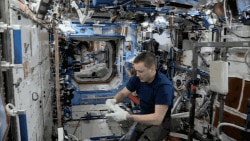Microbes carried on the bodies of visiting astronauts are being sampled on board the International Space Station in hopes of learning how to better protect their health and the health of people on Earth.
“Microbial tracking” is a series of experiments in which samples are taken by ISS crew members and studied by researchers on the ground. The experiments have shown microorganisms living on surfaces inside the space station so closely resembled those on an astronaut’s skin that scientists could tell when a new crew member arrived and departed, just by looking at the microbes left behind.
The findings show how monitoring microbes will be important for protecting the health of astronauts on the ISS and in future long-term space projects. But they could also tell us something about relatively closed environments on Earth, like hospitals, where understanding the presence of microbes and other potentially dangerous organisms have never been more important.
Livermore National Laboratory Biologist Crystal Jaing is the principal investigator for the microbial tracking study. She says understanding how the space station crew interacts with the “microbial community” is important to prevent complications for human health on a spacecraft during long flights, or, perhaps, in a home, on public transportation or a hospital.
Results of the study were published last week in the science journal PLOS One.








